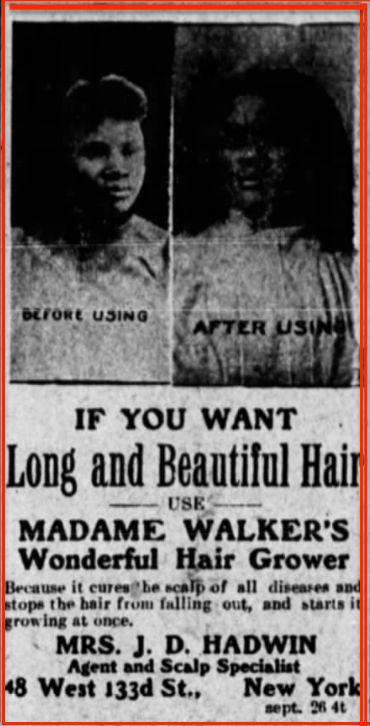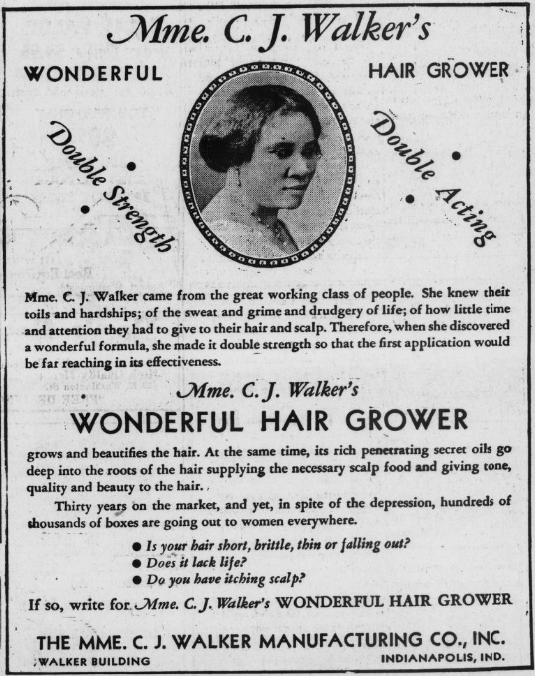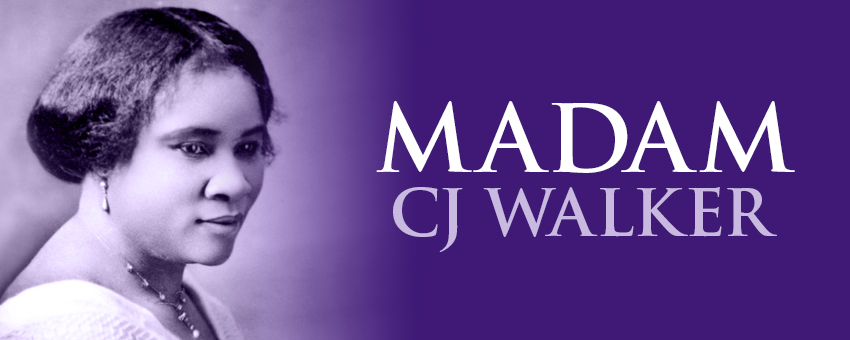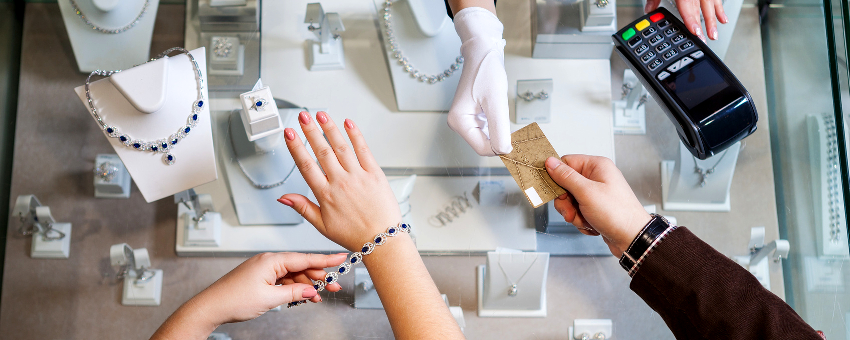The First Female Self-Made Millionaire (Whom You’ve Probably Never Heard Of)
Updated on July 15, 2021This week, at the onset of Black History Month, I wanted to recognize one of the most inspiring (and often overlooked accomplishments) of one of America’s first self-made entrepreneurs.
She is a Black American who built a multi-million-dollar enterprise that began in 1905, a full 15 years before women could even vote. Her story is inspiring and filled with entrepreneurial wisdom that’s still valuable today — and that’s what I hope to share with you today.
As a business owner, she faced many of the challenges we might encounter today (plus a ton that were unique to her in her time), like:
- How to find and target her ideal customer
- How to set her business apart from competitors
- How to promote and advertise her business
- How to scale and hire more staff without micromanaging everyone
And I can almost guarantee you’ve never heard of her! Keep reading, and let’s dive in together.
Let me start with a quick introduction:
Madam C.J. Walker was actually born Sarah Breedlove on December 23, 1867, on the Louisiana cotton plantation where her parents had been enslaved and recently freed. She was the first of five children born free.
Sarah’s parents died of unknown causes when she was just seven, and this was just the beginning of a tough few decades for her. She bounced from Louisiana to Mississippi, and, after a failed marriage, with her first child in tow, she found her way to Missouri.
She landed in St. Louis, where her brothers were established barbers. There, she working during the day as a washerwoman while attending night classes when she could.
St. Louis is where Sarah met her future husband, Charles J. Walker — an advertising professional who would help cement her story in the annals of Black business owner history.
Finding a Niche and an Underserved Market for a Burgeoning Business
Like many modern-day entrepreneurs, Sarah discovered a void in the market — and then built a business by developing a product to fill that void.
When a scalp disorder caused severe hair loss, she refused to follow the status quo of what Black women of the time usually did — cover up with headwear. She wasn’t going to cover up and hide. She was driven to elevate not only her own status but also the status of the American Black woman.
This was when she decided to start poking around for hair and scalp treatment methods. While she did find several products for hair loss, they were from businesses that focused primarily on Indo-European hair. There wasn’t a solution for her or people who shared her concerns.
It motivated her to find a real solution. She began tinkering with different combinations of home remedies and store-bought solutions to find something that worked specifically for her hair.
This is where she found Annie Turnbo Malone’s line of Black-centric beauty products. Turnbo was a successful, Black hair care product entrepreneur that eventually hired Sarah as a sales commission agent. In 1905, Sarah moved to Denver to continue selling Turnbo’s products — and continue perfecting her own line of hair care treatments.
This is where she finalized her recipe for her famous product and application method. The origin of the product’s recipe is still foggy to this day — there are accounts that the formula came to her in a dream while others that claim she simply modified Turnbo’s recipe.
But what really differentiated Sarah’s product from her former employers wasn’t necessarily the product itself, but her presentation and promotion (which we’ll touch on in a sec). She emphasized Black women’s health as its overall effect and started by selling directly to Black consumers.
She used her product as an empowerment tool for Black women. Her “sales pitch,” if you will, was that these products were built for Black women, by Black women, with their needs at the forefront.
When I developed the first completely in-house direct mail printing and marketing service, it wasn’t like I reinvented the wheel. In this industry, yes. But the model existed elsewhere.
I took aspects from several other successful businesses and combined them into a cohesive service that was the first of its kind within this industry. Other companies had offered free advice before, but free marketing advice? That wasn’t really a thing.
Many multi-million dollar companies out there today follow this same formula — they find a niche, put together a business that addresses it, find a way to differentiate that business, then continue improving.
Sarah Breedlove’s product, combined with the application method and self-empowering approach to business, could be labeled as her Unique Selling Proposition, or what set her apart from other Black beauty suppliers of the time.
She Utilized Modern-Day Promotional Strategies Before They Were Cool (Or Existed)
In Denver, Sarah’s husband, Charles, began helping her advertise her products. He suggested changing her name to “Madam C.J. Walker” — his thinking was that it was more recognizable and memorable than Sarah Breedlove.
It was branding before “branding” existed. They knew exactly what they were doing — creating something that would make an impression.
The name stuck, and Sarah Breedlove became Madam C.J. Walker overnight, and a legend was born.
Once she finalized her recipe for “Madam Walker’s Wonderful Hair Grower,” she needed to find the best way to promote it. The options for marketing back then were extremely limited, and any technology available cost an arm and a leg.
In 1907, Madam Walker and her husband decided to travel around the South and Southeast, promoting her products through door-to-door sales, traveling kiosks set up in town centers, and by word of mouth.
This was their marketing tactic. They needed to get the word out, and nothing is as affordable as walking door to door with your product when you have a surplus of time and a shortage of capital.
Interesting tidbit:
The first wide-scale direct mail campaign is considered to have been run by the founder of Sears in the 1880s when he mailed a one-page flyer to rural and small-town consumers selling watches.
So, by the time Madam Walker was around, direct mail would have been brand new (and probably very pricey) technology.
Madam Walker’s method would be considered the “old school” tactic to direct marketing.
Her marketing and salesmanship arguably became more popular even than the products. Her emphasis on the health and social status of Black women resonated strongly with her target audience. The complete package she sold became known as the “Walker Method” — her own hair regrowth formula using scalp preparation, pomade, and brushing the hair with heated combs.
This successful approach to selling is supported by today’s marketing studies – 80% of consumers are more likely to make a purchase when a company offers more personalized experiences.
This direct marketing approach was a huge success, and her profits exploded.
Positioning Her Product as a Holistic Health Treatment (Rather than a Hair Product) Boomed Business
Motivated to be a gleaming example of what a poor Black woman could do in America while also helping others achieve their goals, she took these newfound profits and opened a factory and a beauty school in Pittsburgh.
By 1910 – just three short years after she began advertising – Madam C.J. had made profits that were the modern-day equivalent of several million dollars.
She decided to move her company to Indianapolis. This new location served as a manufacturing plant and a training facility for sales beauticians that would come to be known as “Walker Agents.”
Walker Agents became renowned throughout Black communities, empowering Black women with the philosophy of “cleanliness and loveliness” in a time where they were repressed and made to feel like they weren’t worthy of equal treatment.
Here’s another marketing lesson we can pull from her story:
A substantial contributing factor to Madam C.J.’s success was this benevolent reputation. She was beloved by the Black press for her success as an entrepreneur and her efforts as a Black rights advocate.
I certainly don’t contribute to charities frequently for the PR benefits; I do it because it’s the right thing to do. However, an additional benefit of being ethical is that people begin to see your company as one of the good ones.
Research shows that consumers are more likely to buy from companies that clearly communicate their ethics.
These Walker Agents effectively grew the business, and she handed off most of her operational duties to her factory foreladies and daughter.
She achieved every business owner’s dream: building a self-sustaining business!
What We Can Learn From Her Successful Ads
Indianapolis is where we can begin to find some authentic advertisements from Madam Walker’s Wonderful Hair Grower that let us look into her marketing efforts after she had the capital to mass-produce print advertising.
As a note:
Madam C.J. continued to scale up her advertising as her business scaled up.
Her business instincts were amazing — and this was without a “proper education,” let alone a business degree.
Many of the tactics she used can be echoed in some of the postcard design elements we still use today! This is a Walker Agent’s print ad, most likely from a newspaper. Does anything look familiar?

It’s a before and after ad!
Few things are as effective in advertising as before and after proof of a product or service working. Personally, I LOVE looking at before and afters, and I love ads that make good use of them.
This roofing contractor postcard design is a modern-day example of a before and after ad. It bears many of the same elements you can find in Madam Walker’s ad above, like:
- A headline that’s clear and bold and communicates a benefit of her product
- Before and after pictures showing her product in action
- Marketing copy that gives the benefits of the product or service
- Contact information that is front and center
Here’s another one:

This poster is more personal. You can see Madam Walker and she talks about her humble beginnings and how her background led to a more effective product overall for people like her — too busy working to worry and fret about hair loss.
I love when ads include photos of real people and real business owners.
Here’s why:
It makes me LIKE the product or service so much better if someone is authentic and says, “This is mine and I stand by it.” That’s exactly what Madam Walker does here.
This ad reminds me of a dental practice’s postcard design I saw recently in a case study of ours.
The design includes a personal note from the dentist, accompanied by a photo of the dentist’s family and some details about his upbringing as a local Texan and a military man. The design builds a sense of community with the recipients — people who care about those things (like helping veterans, buying local, etc.) are more likely to go out of their way to become a patient of this dentist.
Good marketing is good marketing, regardless of which century it’s from.
Obviously, technology has majorly shifted the typical consumer’s expectations, but at the end of the day, people really haven’t changed all that much. The world around us has.
I hope you enjoyed Madam C.J. Walker’s story and were able to pull some inspiration from it. I know the first time I heard her story, I was awestruck!! What a badass!!!
All of our marketing consultants here are trained on every concept mentioned above — if you’re looking for any marketing advice, reach out to 800-628-1804! Our advice is always 100% free.
And if you decide to work with us, fantastic! If not, cool! Our goal is to help small businesses everywhere improve, not just our bottom line.
Best,
Joy







Excellent stories and examples!